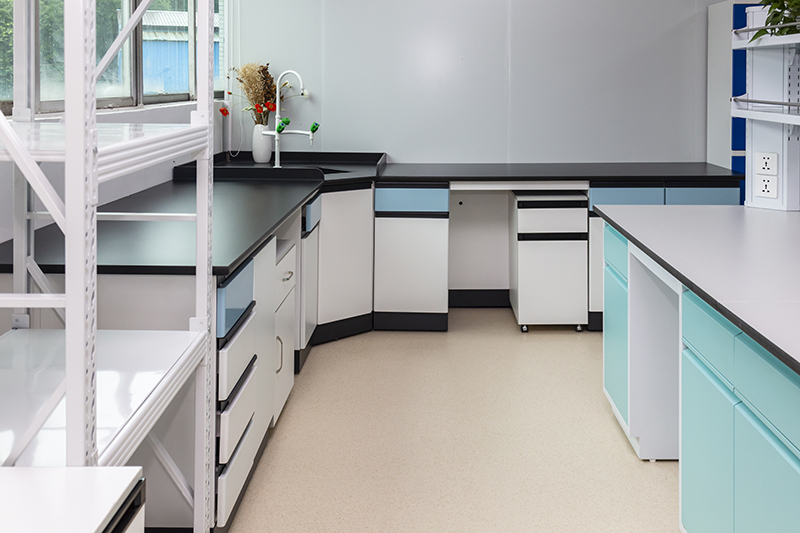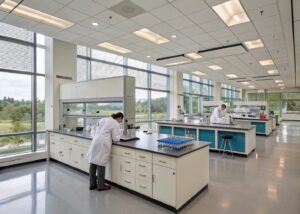What Is Scientific Lab Furniture
Scientific lab furniture refers to the specialized furnishings designed to meet the specific needs of a laboratory environment. This includes workbenches, storage cabinets, fume hoods, seating, and more, all tailored to provide a safe, efficient, and ergonomic workspace for scientists and researchers. These pieces are crafted to withstand rigorous use and exposure to chemicals, ensuring durability and functionality in a variety of scientific settings.
How Many Types of Scientific Lab Furniture
Scientific lab furniture can be broadly categorized into several types based on their function:
Lab Workbenches and Tables
General Workbenches: Sturdy surfaces for general lab tasks.
Height Adjustable Tables: Allow customization for ergonomic comfort.
Mobile Workstations: Provide flexibility and mobility within the lab.
Storage Solution
Cabinets: For storing chemicals, glassware, and equipment.
Shelving Units: Open or closed shelving for easy access and organization.
Lockers: Secure storage for personal items and lab coats.
Safety Equipment
Fume Hoods: Essential for handling volatile chemicals safely.
Safety Cabinets: For the secure storage of flammable or hazardous materials.
Eye Wash Stations and Safety Showers: Critical for emergency situations.
Seating
Laboratory Chairs and Stools: Designed for comfort and durability, with adjustable features to support long hours of work.
What Is the Best Material for Scientific Lab Furniture?
The best material for scientific lab furniture depends on the specific needs of the laboratory, but some common choices include:
Stainless Steel
Durability: Resistant to corrosion and easy to clean.
Hygiene: Nonporous surface prevents bacterial growth.
About the stainless steel and cold rolled steel lab furniture, for more details please refer to this article:
Phenolic Resin
Chemical Resistance: Excellent resistance to a wide range of chemicals.
Durability: Strong and long-lasting, ideal for heavy-duty use.
Epoxy Resin
Chemical Resistance: High resistance to chemicals and heat.
Durability: Durable and nonporous, making it easy to clean and maintain.
About phenolic resin and epoxy resin, please refer this article:
Polypropylene
Chemical Resistance: Resistant to most acids and solvents.
Durability: Lightweight yet durable, suitable for many lab applications.
The Application of Scientific Lab Furniture
Scientific lab furniture is used across various types of laboratories, each with unique requirements:
Chemical Laboratories
Workbenches with Chemical Resistance: To handle corrosive substances.
Fume Hoods: Essential for safe chemical handling.
Biological Laboratories
Laminar Flow Cabinets: For maintaining sterile environments.
Autoclave Resistant Work Surfaces: For handling high temperature sterilization equipment.
Physics Laboratories
Antivibration Tables: For sensitive experiments requiring stable surfaces.
Storage Cabinets: For equipment and material storage.
Durable Workstations: Built to withstand constant use by students.
Versatile Storage Solutions: To accommodate various teaching materials and equipment.
Which Factor Is the Most Important When You Are Considering to Buy Scientific Lab Furniture?
When purchasing scientific lab furniture, safety is the most critical factor. Ensuring that the furniture meets all safety standards and regulations is paramount to protect lab personnel and maintain a safe working environment. This includes considering:
Chemical Resistance: Furniture should withstand exposure to the chemicals used in the lab.
Ergonomics: Proper design to prevent strain and injury during long periods of use.
Durability: High-quality materials that offer longevity and withstand daily wear and tear.
Compliance: Adherence to industry standards and safety certifications.
What Lab Furniture Is a Must-have in a Science Lab, and Why?
Certain pieces of lab furniture are essential for any science lab to function effectively:
Workbenches
Versatility: Provide a stable surface for a variety of tasks.
Durability: Built to withstand heavy use and chemical exposure.
Fume Hoods
Safety: Crucial for the safe handling of volatile substances, protecting both the user and the lab environment.
Storage Cabinets
Organization: Essential for keeping the lab orderly and efficient.
Safety: Secure storage for hazardous materials, ensuring compliance with safety regulations.
Laboratory Seating
Comfort and Ergonomics: Supports scientists during long hours of work, reducing the risk of injury.
How to Evaluate If the Lab Furniture Meets Science Lab Standards?
Evaluating lab furniture for compliance with science lab standards involves several key steps:
Check Certifications: Ensure the furniture meets industry standards such as OSHA (Occupational Safety and Health Administration) and SEFA (Scientific Equipment and Furniture Association).
Material Quality: Assess the resistance to chemicals, heat, and wear.
Safety Features: Verify the presence of necessary safety features like fume hoods and safety cabinets.
Ergonomic Design: Ensure that the furniture is designed to promote good posture and reduce strain.
Customer Reviews and Case Studies: Look for feedback from other laboratories and real-world applications to gauge performance and reliability.
What Feature of Science Lab Furniture Is Most Favored by Scientists?
Scientists often prioritize the following features in lab furniture:
Durability and Chemical Resistance
Reliability: Furniture that stands up to the demands of a busy lab without deteriorating quickly.
Ease of Maintenance: Surfaces that are easy to clean and maintain contribute to a safer and more efficient lab environment.
Ergonomic Design
Comfort: Furniture that supports proper posture and reduces strain during extended periods of work.
Adjustability: Height adjustable tables and chairs that cater to individual preferences and tasks.
Safety Features
Integrated Safety Equipment: Built-in fume hoods, eye wash stations, and safety showers enhance the overall safety of the lab.
Secure Storage: Lockable cabinets and drawers for hazardous materials and sensitive equipment.
In summary, selecting the right scientific lab furniture involves considering durability, material quality, safety features, and ergonomic design. By understanding these key factors, you can make a right decisions that ensure their laboratory is well-equipped to handle the demands of scientific research and experimentation.




